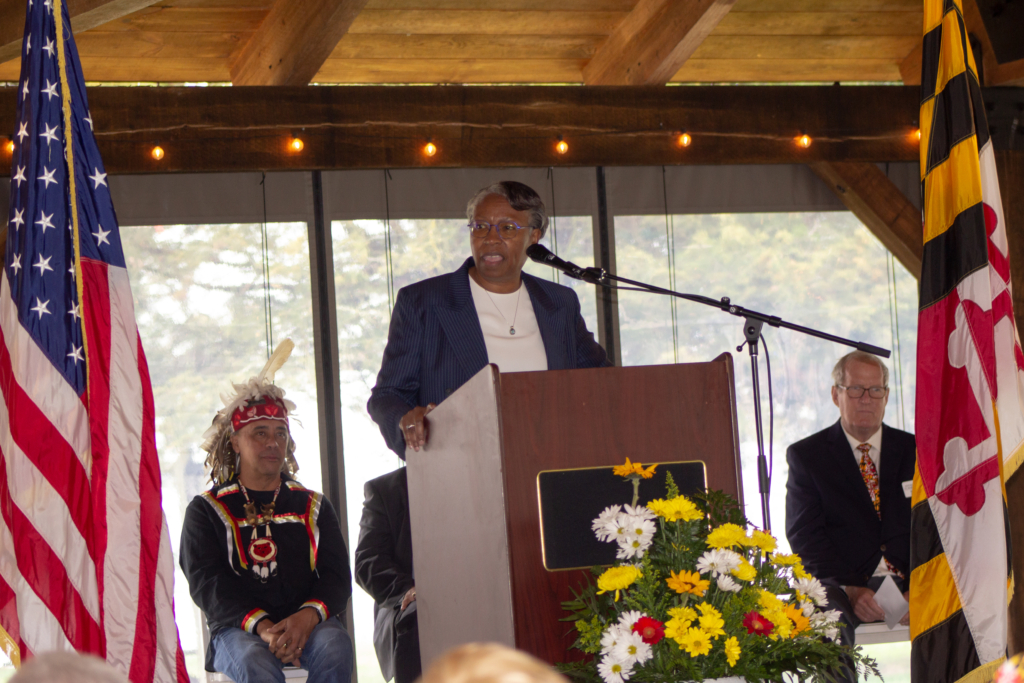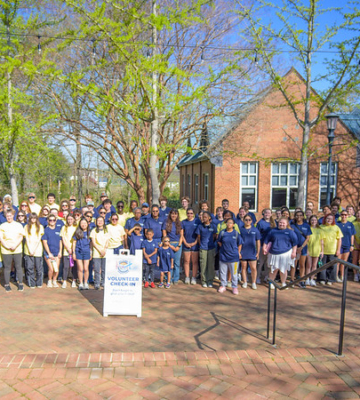
On March 25, 2023, President Jordan was the invited keynote speaker at Historic St. Mary’s City’s Maryland Day ceremony. The packed-house event was held under the new Margaret Brent Pavilion at HSMC.
I want to thank the organizers of this event, specifically Regina Faden, for inviting me to provide some remarks on this auspicious occasion, “the day in 1903 the State Board of Education designated as a day to be devoted to the study of Maryland history.”[1] What is Maryland Day about? Until I was invited to provide the keynote address, I had never given this occasion any thought. Why that is the case is complicated and, fortunately, not the subject of today’s remarks.
Maryland Day commemorates the formal founding of the colony of Maryland, when the newly-arrived colonists erected a cross on St. Clement’s Island, offered prayers, and took “possession of this Country for our Savior and for our sovereign Lord the King of England.”[2]The reference I consulted went on to read that “after consulting with the ‘Emperor of the Paschataway’ and the ‘King of Yaocomoco (YAO-COCO-MEECO),’ Leonard Calvert, governor of the colony, negotiated the purchase of land on a nearby tributary of the Potomac River. This became the site of St. Mary’s City, the colony’s first settlement.”
This is an interesting telling of the tale of the founding of this State. It is so befitting for us to be here in St. Mary’s City and at a point at which we can provide a bit more insight, a more complete narrative of what occurred between the colonists and the people who called this place home long before the arrival of the Europeans. The time is past due. It is time for all of us to make a committed effort to shine the light on a deeper understanding, a more complete telling of the history of the founding of the State and the history of this nation.
There are some who want to cast shadows on how we came to be the nation that we are but we, here at the home of Maryland’s first capital, are poised to provide illumination and to be leaders in what I call the second period of Enlightenment in this nation.
There is a growing movement afoot that both intrigues and frustrates me. I sometimes refer to it as the “Ignorance is Bliss” movement and it seems to be the next chapter in the Book of Deniers where adults don’t want their children or others to be exposed to anything that casts a dim light, one of potential disparagement, on history. Ah, the fragility of the human condition. We have seen this behavior repeat itself throughout history. But, discovery and knowledge represent enlightenment. And we must celebrate light.
Maryland is, after all, the home of the Space Telescope Science Center in Baltimore as well as the State that took the lead in the design and development of the James Webb Space telescope in partnership with others. We are shedding light on the farthest galaxies, what appear with the naked eye to be the darkest corners of the universe. Why not do so at home? Furthermore, we are the birthplace of many who signed the Declaration of Independence and who participated in the development of the US Constitution, the foundation of our democracy. Democracy thrives when and where there is light. And as Marylanders, living in a place founded as the site of religious toleration, a place that espouses the principle of Freedom of Conscience, we must take up this yoke and lead this country out of the morass in which we find ourselves. We must let this little light of ours, as the 8th smallest state in the union (by land mass)[3], shine.
An educated society is a free society; a vibrant, thriving, and sustained society. There are people in positions of power in several states who are doing everything they can to control what is taught in the classrooms across every level of education. It is appalling yet fascinating at the same time. This attempt at control puts us on a dangerous path. A Chief US District Court judge has blocked implementation of a legislation in one particular state that would have prohibited teaching of a broader narrative of a segment of US history. His words are very important as we consider the link between an educated citizenry and democracy. He wrote[4] in part, that limiting what is taught strikes at the heart of ‘open-mindedness and critical inquiry’. Both robust intellectual inquiry and democracy require light to thrive.” He goes on to say that our teachers “are critical to a healthy democracy” and that “if ‘our priests of democracy’ are not allowed to shed light on challenging ideas, then democracy will die in darkness.” This is powerfully profound. We are all teachers in our own way. Thus, we should all heed the warning.
When I was taught US history, I was told that America is a melting pot. As I matured, I began to wonder about that metaphor. Why do we have to be a melting pot? I understand the implied cohesiveness of coming together and be as one but why must we all appear to be the same? Many of you have heard me ask this question before but it’s a valid question: why not be a gumbo? In a gumbo you can identify the component parts and they are all very good individually. Together, however, they are richer and more excellent. Why not let the telling of our history represent the richness and complexity of a gumbo?
The history of our country is complex. People have come from virtually every part of the world and, with the peoples who are native to this land, have created a nation like none other. To understand who we are and to realize our full potential, we must acknowledge and tell the stories from all perspectives.
What better place to commit to enhancing the narrative of our nation’s history than the State of Maryland? We are, after all, one of the most multi-cultural[5] and highly educated states in the nation. We should thus be the manifestation of Freedom of Conscience, a place that values knowledge and information, a place that believes that our citizens have the right to be educated, have the ability to think critically about what they learn and to use their voices to help this nation continue to work towards becoming a more perfect union where all are treated equally and all should have the inalienable rights to pursue life, liberty, and justice. This is what Maryland should be about on Maryland Day and every day.
Here on this peninsula in Southern Maryland, we are a community of both informal and formal educators who are working to enhance the narrative of the history of our country. Today, I will provide three brief examples out of many institutions that are working to be more inclusive and to make more prominent those who are less visible in the history books.
Historic Sotterley serves as a model of what becomes possible when the historical narrative is expanded to include multiple perspectives of what life was about during a specific time period. They boldly state on their website that “With honesty and integrity, Sotterley embraces our responsibility to interpret all aspects of our shared history.” Their Descendants Project is exemplary and has been included at the Smithsonian’s National Museum of African American History and Culture and they are active participants in the national conversation focused on the descendants of slavery. The commitment of the stewards of this three-century-old site to broaden the narrative as well as their informal educational and cultural programs has not only garnered national acclaim for its work, but it has helped us all value and appreciate the complexity of the time and to better understand the ties that bind, rather than separate, us as humans.
As a higher education institution, St. Mary’s College of Maryland of course provides formal opportunities for our students, faculty, and staff to delve into the history of this place and to contribute to the discovery, interpretation, and dissemination of this knowledge to both the intellectual and broader communities. However, we recognize that we have a responsibility to also participate in the informal education of society much more broadly and to both talk the talk and walk the walk. Our Commemorative to the Enslaved Peoples of Southern Maryland, an edifice used for both formal and informal educational endeavors, is part of our efforts to provide voice to the voiceless and to make that which is obscured visible. That structure truly is a celebration, thus our calling it a commemorative, and acknowledgement of those who toiled this land and it has garnered national and international attention and awards. As a campus founded as the monument school, we are committed to understanding the who, what, when, how and why of this place, working with others to understand the impact of all of this, and to disseminate that information broadly and as accurately as possible. An example of our active commitment to this mission, is the land acknowledgment and pledge that we read at major public events. Like many institutions, we read a land acknowledgement in recognition of the fact that the land was originally acquired by what we consider today less than honorable means. Unlike most places, however, the acknowledgement recognizes both the indigenous and enslaved peoples of the area and with the acknowledgement is the College’s pledge to continue to be seekers and tellers of the complete history of this place in an effort to both commemorate the remarkable achievements of the past as well as right societal ills that were borne out of the systems instituted in the past and are negatively impacting our lives today.
The mission of the Historic St. Mary’s Commission is to “preserve and protect the archeological and historical record of Maryland’s first colonial capital and to appropriately develop and use this historic and scenic site for the education, enjoyment, and general benefit of the public.” Over the years I have seen a transformation in how this charge is interpreted and fulfilled. The telling of the story of the establishment of the first capital of the State has become richer and more inclusive and it will be expanded by the recent discovery of the long sought-after fort. And, I want to take a moment to again congratulate Dr. Travis Parno and his team – which included St. Mary’s College students – on this incredibly important find. The narrative of the establishment of this republic will certainly be enhanced by a greater understanding of the relationship between the colonists, the native peoples, the indentured servants, and the enslaved whose lives were impacted by that structure…a fort. Since its discovery, I often find myself pondering the need for a fort if, as referenced earlier in my remarks, Leonard Calvert indeed consulted and negotiated with “the ‘Emperor of the Paschataway’ and the ‘King of Yaocomoco (YAO-COCO-MEECO),’” respectively, for the land. As you know, I’m no historian or anthropologist. I am just a biochemist so I don’t understand the intricacies of the colonial period. But I do have some understanding of both the purpose of forts and human nature. Parts of the history of this social structure as well as the interactions between the members of that “community” will surely be adjusted and I have no doubt that when that occurs, more people will take pride in this democracy because they will directly see the role their ancestors played in building it.
Here in Southern Maryland, we have these three major entities, Historic Sotterley, St. Mary’s College of Maryland, and the Historic St. Mary’s Commission, and others, e.g. the Unified Committee for Afro-American Contributions, working independently, together and in partnership to ensure that we tell a more complete story of the role Maryland played in building this nation and shaping this democracy. Within our unique community we also have the support of our local legislators, specifically Sen. Jack Bailey and Del. Brian Crosby, who help us get the resources that sustain us. And, we have a broad community of volunteers that help us get our work done. Thank you all for contributing to this important work.
Maryland Day. Why is this day important? Yes, it affords us the opportunity to acknowledge the arrival of the colonists to what became known as Maryland in honor of the King of England’s wife, Henrietta Maria, who was known as Mary[6]. It also, importantly, provides us with the very real opportunity to reflect on and commemorate what it took to get us to where we are, to acknowledge all who contributed to our being here, and then commit to leading this country to a brighter future, one that is proud of the diversity that we represent, one that is committed to fostering inclusiveness, and fairness. As American philosopher and classicist Allan David Bloom is credited with saying, “education is the movement from darkness to light.” It is in this way, through the enlightenment that comes through education, that we can empower the people and ensure that our light continues to shine and our democracy, by the people and for the people, will thrive. As educators in the broadest sense of the term, we must proudly continue to let the light shine and illuminate the path to a brighter future for us all.
Thank you.
[1] www.marylandday.org
[2] Ibid.
[3] Wikipedia Maryland entry https://en.wikipedia.org/wiki/Maryland
[4] Reported in Inside Higher Ed, https://www.insidehighered.com/news/2023/03/17/floridas-stop-woke-act-continues-be-blocked-colleges?utm_source=Inside+Higher+Ed&utm_campaign=5ddd470a95-DNU_2021_COPY_02&utm_medium=email&utm_term=0_1fcbc04421-5ddd470a95-199442005&mc_cid=5ddd470a95&mc_eid=36f9779276
[5] Wikipedia ibid
[6] Wikipedia Maryland entry https://en.wikipedia.org/wiki/Maryland


